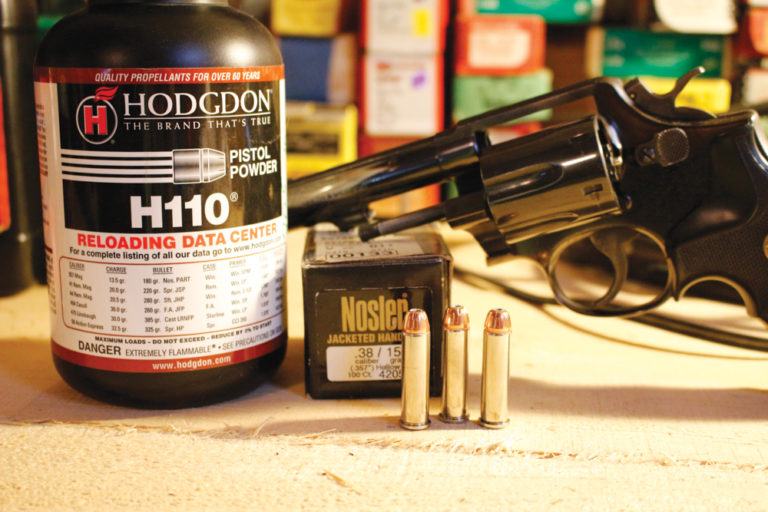
- The .357 Mag. and .44 Mag are considered classic hunting revolver cartridges the author has used effectively on all manner of game and predator.
- Both cartridges are a dream come true for the handloader given the abundance of components in today’s reloading market.
- Handloading for classic revolvers can not only rejuvenate your interest in them, but breathe new life and accuracy with modern bullets and powders.
Modern reloading of hunting revolver ammo can bring newfound interest to old iron.
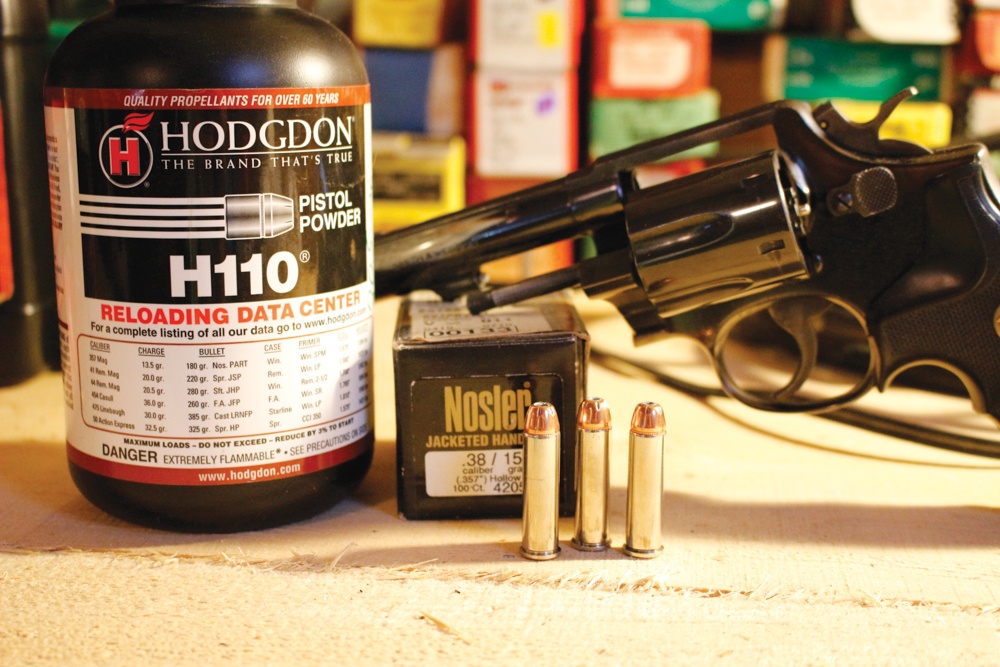
Modern reloading of hunting revolver ammo can bring newfound interest to old iron.
I own a pair of classic revolvers. One is a 1979 Model 13 K-frame with a 4-inch heavy barrel, chambered in .357 Magnum with Pachmayr grips. I inherited this gun, which was once my father’s favorite handgun, and is now very dear to me.
My other favorite is a 1957 pre-model 29 N-frame with a 6 ½-inch barrel chambered in — of course — the classic .44 Remington Magnum. In preparation for writing this article, I had the pleasant opportunity to breathe some new life into these old guns by using some new bullet and powder combinations.
.357 Magnum Reloads
Though not looked upon by many as a hunting pistol, my old standby sidearm is the Smith & Wesson Model 13 chambered in .357 Magnum, with a 4-inch barrel.
Considered by many to be underpowered — and some have even called it “wimpy” — I have used this gun enough to know differently. Throughout my life I have tried to redefine the basic laws of physics, but have always failed miserably, usually resulting in broken bones, stitches, or some type of hard-learned lesson. I quickly learned that I cannot change these laws and that basic physics will always win.
Applying these pesky laws, I have found a 158-grain Hornady XTP with a muzzle velocity of 1,170 fps, when put in the right place, deals with all the critters I generally contend with here in Upstate New York.
Most of my data for the .357 may not be impressive in comparison to many reloading manuals or most of the Internet experts, but these loads were all derived from field testing in my 4-inch-barreled Model 13, as opposed to being tested in a Universal Receiver with a 10-inch barrel, which will generate higher velocities and pressures that are not realistic from my handguns.
 Here are the strengths and weaknesses of this revolver: First off, it’s a pleasure to carry. It fits right on your belt and is easily concealed so you’re not taking your gun off every time you go out. Here in Upstate New York our laws prohibit open carry; it’s concealed carry only.
Here are the strengths and weaknesses of this revolver: First off, it’s a pleasure to carry. It fits right on your belt and is easily concealed so you’re not taking your gun off every time you go out. Here in Upstate New York our laws prohibit open carry; it’s concealed carry only.
One of my favorite things about this handgun is the fact that I can feed it .38 Special ammunition all day long and have a very accurate plinking gun. This is the gun’s usual diet; unless, of course, it’s deer season. Its recoil is very manageable even with full-house loads, especially when compared to other hunting calibers.
My wife shoots it regularly, and very accurately at that. When going out to do chores, this is the gun to wear. It doesn’t get in your way on your belt and doesn’t slow you down while working. That’s not something that can be said of carrying an X-frame revolver.
Secondly, when this little gun is off its diet of .38 Specials, it’s fed with premium bullets, usually Barnes XPBs or Hornady’s XTPs, and it’s never had a problem putting venison in the freezer or exterminating any of the predators that always seem to be in my chicken coop.

One of its downfalls is its effective range, as it is limited by its 4-inch barrel. It’s a tradeoff that is offset by the handiness of the gun. I limit myself to a 50-yard shot at deer, and only if I have a clear shot at its vitals.
At 50 yards I know I can shoot it accurately enough to make a solid hit and the bullet will still retain enough energy to get the job done cleanly. I don’t consider myself to be a good enough shot to shoot any farther than this at any animal, as both accuracy and energies diminish to the point that I am not comfortable.
The limited sight radius on this short-barreled gun not only makes it less accurate than, for example, an 8-inch barreled sixgun, but once again those damned laws of physics rear their ugly heads; you don’t have the velocity or energy generated by a longer barrel.
.44 Magnum Handloading
My other favorite hunting revolvers is my 1957 Smith & Wesson pre-29 .44 Remington Magnum with a 6 ½-inch barrel. I got lucky and found this gun at a local shop for a great price.
This gun can shoot better than I can, with just about any load. It has a great trigger and balances perfect for me. It does not fit on the hip as well as my .357, but it is still much easier to carry than a rifle. With its 6 ½-inch barrel, the sight radius is much longer than the .357’s 4-inch tube, thus making it much more accurate to shoot.
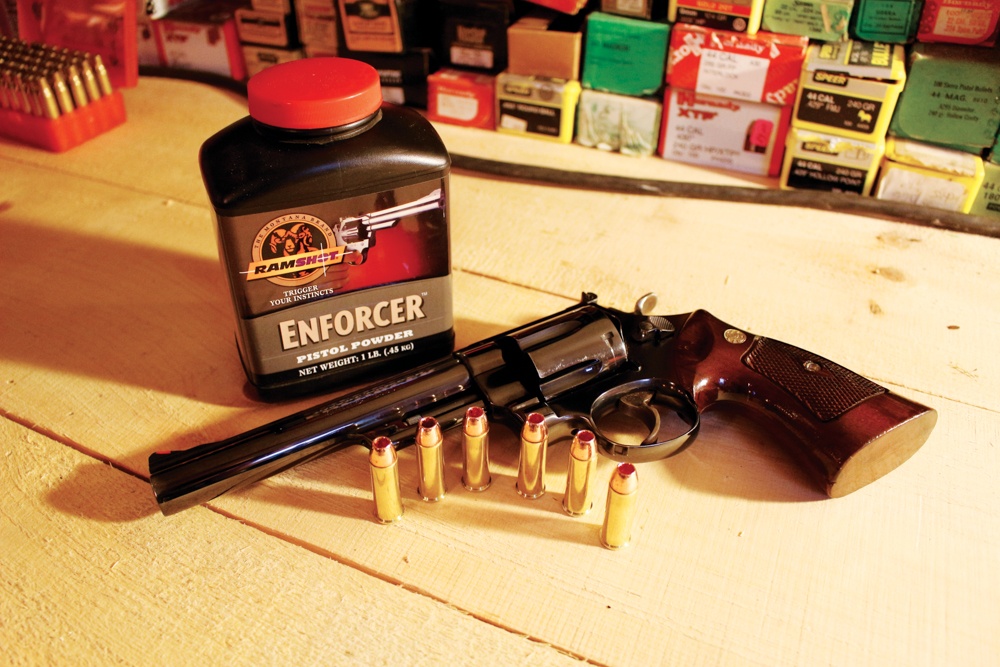
I find this to be the optimal length for me when hunting with iron sights, but I still limit myself to 100-yard shots with it. I know there are plenty of people who can shoot an identical gun a lot farther, but this is my limit for iron sights.
In my neck of the woods, most deer hunting is done within 100 yards or less. I find target acquisition to be very fast with this gun, when compared to a scoped pistol. Now, I am not going to lie; usually a scoped single-shot or a big X-frame in .460 or .500 will shoot a hell of a lot more accurately than my old .44, but this .44 Magnum is about as big a handgun as I can shoot accurately offhand. I stress “offhand” and mean shooting it without a rest or fence post or anything to support the weight of the gun.
I can shoot my .460 Smith & Wesson at twice the distance and with twice the accuracy. But here’s the kicker: I can’t shoot it offhand, I can only shoot it well from a rest or supported position. It weighs too much for me to group accurately offhand. It also wears a 2.5×8 scope and has 12 inches of barrel. Is it still a handgun if you can’t shoot it like a handgun? I will let you decide.
I will also include data for a couple of .44 Special loads because this is what I normally practice with. They are much easier on the gun and my wrist, not to mention cheaper to shoot.
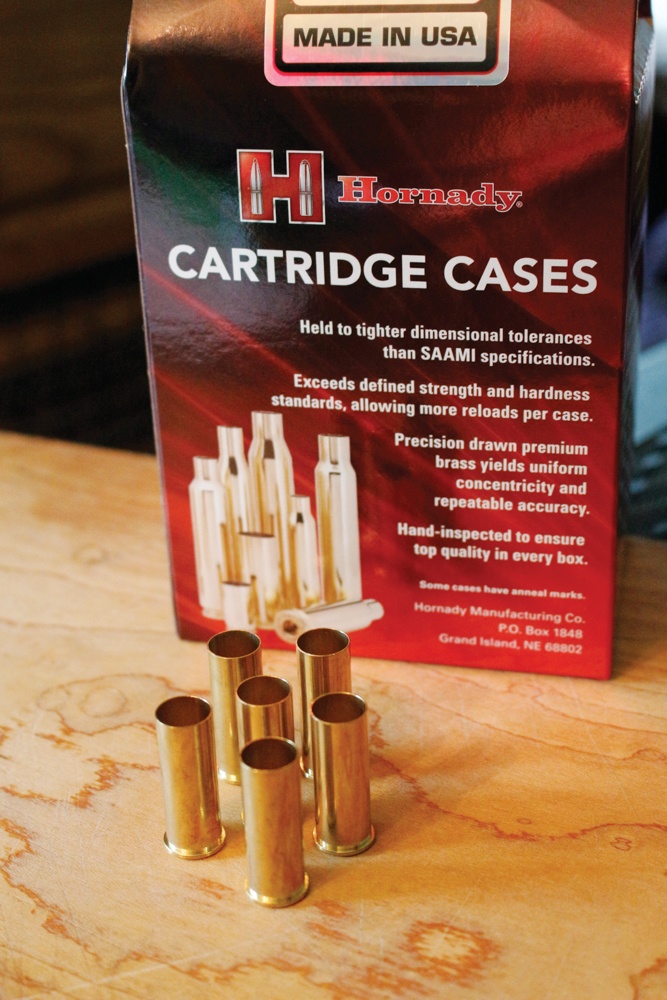
Reloading Revolver Ammo
My reloading methods are by no means considered the latest and greatest, or even advanced. Most anyone can replicate my loads with similar results. In fact, some are considered outdated by most of the people in the reloading crowd. I was even called a dinosaur this week because of some of the Winchester powder I was using.
My gun/reloading room is a hodgepodge of reloading equipment, some of which are antiques, and some of my preferred powders have been around for over 50 years. I am generally of the mindset of, “If it ain’t broke, don’t fix it,” but I have started to use some of the modern products recently. Trying some of the new bullets and powders has given me very impressive results that I did not think possible.
For this article I used all new dies, brass, primers, and bullets to take out some of the variables.
Don’t get me wrong; I will always be the guy that saves all brass until it splits or the primers won’t stay seated. But using some of today’s new products has shown me that there are more efficient ways to handload.
We will start off with the die sets. Most of my dies are yard sale specials, hand-me-downs, or bought off the clearance rack. I acquired new dies from Redding, to ensure there was no wear and tear. While using these new dies, in comparison to my old ones, all I can say is “Wow, these things are amazing!”
The Redding sets feature micrometer-adjustable seating and crimping dies. The dies are fast and easy to get set up and have given the best crimp I have ever achieved. Their ease of adjustment saves a lot of time when you’re changing between different bullets. To be honest, I don’t know how I am going to go back to using my old ones.
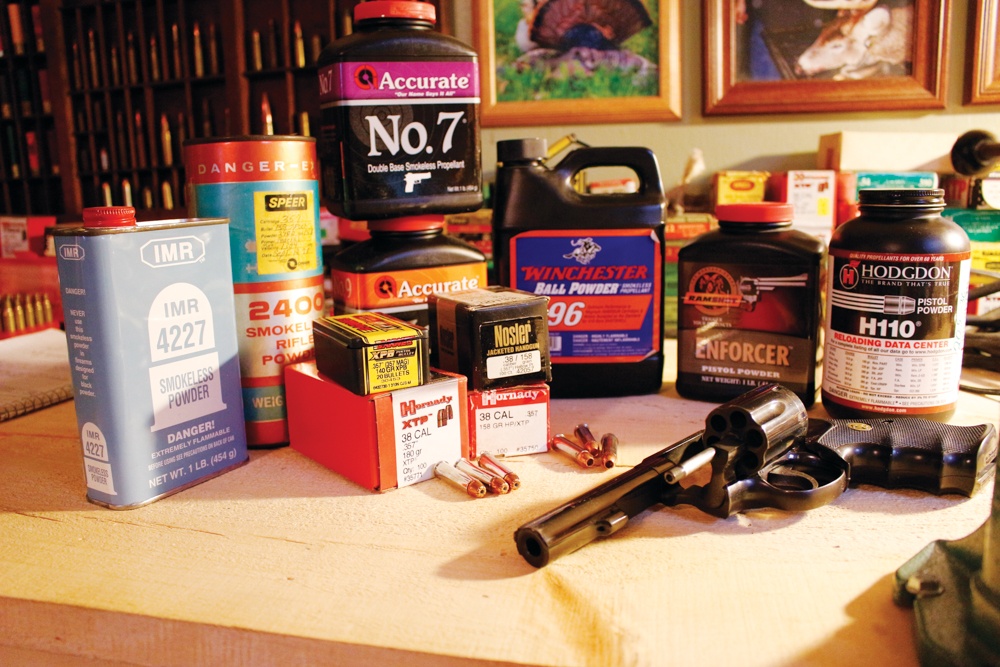
For this experiment, I used brand-new Hornady brass cases. I spent the better half of a day measuring and weighing this brass, and did not find a single problem. I am a real stickler for trimming all pistol brass to get the perfect pistol crimp, but this brass is of such quality that trimming was not required. When the brass is of a uniform length, the crimping die will give an equally uniform crimp on the bullet’s cannelure.
If your brass isn’t trimmed to a uniform length, the resulting crimp will be all over the map, and can drastically affect the function of the revolver, as well as velocity and accuracy. All the cases weighed and measured were well within my strict standards. All were of uniform weight and length. Hornady really impressed me with their product. If you have never used new brass before, you should try it. You will be amazed.
For the primers, I used all Federal Gold Medal Match primers, small pistol primers for the .357, and large magnum pistol for the .44 Magnum. I have used them for years and found them to give the most consistent ignition, and I always keep a large supply on hand.
Now, on to the powders.

I wanted to use some old standby powders to compare with some of the new propellants on the market. I started off with Hodgdon H110. I have used this stuff often in the past, so I know how predictable the results are. I have also been happy with the accuracy of this powder, often giving me fantastic accuracy and consistent velocities. It meters very smoothly and consistently.
I also used some Alliant 2400, a top performer that I have been using for years. I wanted to try some new powders with this batch of premium bullets, so I grabbed Accurate #9, and Ramshot Enforcer, as these both work very well with the all-copper bullets I used for testing.
Despite my old-school mentality and utter reliance on my old standby loads, both gave top velocities and fantastic accuracy. I think the Enforcer might end up my new pet load for the .44 Mag., replacing my old loads of Alliant 2400 in the old wheelgun.
Ramshot’s Enforcer not only proved most accurate, but also gave among the highest velocities, something that rarely happens.
This powder, made in Belgium, meters perfect and burns surprisingly clean. Enforcer seems to be made for the .44 Magnum. I like it so much that I will be stocking up on more of this powder. Enforcer worked great in the .357 Magnum, too, being tied with the Accurate #9 for top accuracy.
The bullets I chose were all premium hunting bullets, as developing hunting loads was my goal, starting with the Hornady XTP.
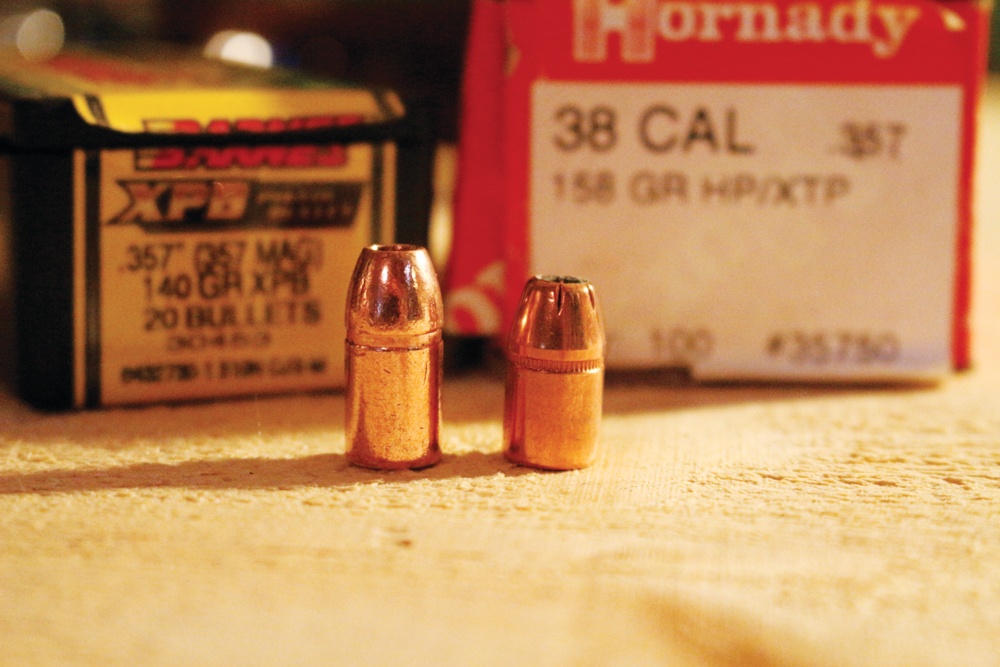
The XTPs have always performed well for me; I have never had one fail. They open up to at least 1 ½ times their original diameter for immediate energy transfer, but also penetrate very deeply.
Any broadside shot I have ever taken with my .44 Magnum has resulted in a complete pass through; I have never recovered any .44 bullet. Deer I have hit with the XTP’s have taken not more than a few steps before expiring. I prefer to use the heavier 300-grain bullets at a slower speed and I am amazed at their performance, whether the distance is 10 yards or 100.
The Nosler jacketed handgun bullet has long been a favorite in my .357, and the 158-grain slugs over a charge of Hodgdon’s H110 has been a magic recipe for years. This has, and will continue to be, a go-to bullet for me.
Another of the premium bullets chosen was the Speer Gold Dot in .44 caliber, weighting 240 grains. These things are accurate and open up a huge hole. Although I have never hit a deer with one, I am sure they would be very effective. Penetration tests suggest they would have no problem passing entirely through a deer.
Two coyotes were taken with these bullets and that’s how I know they open up so fast. They leave a Buick-sized exit wound — most impressive! As far as a defensive bullet, they might be overkill but I would not hesitate to use them.

Whether you love them or hate them, the Barnes XPBs are the hot rods of handgun bullets. What I like about Barnes is that bullets are all that they make — just bullets. And they have been doing this for over 80 years. They seem to do a lot more research in the ballistic department than all the other companies.
These bullets are an all-copper design with a massive hollowpoint cavity, which upon impact forms the shape of a mushroom with razor-like pedals. These controlled expansion-type bullets give devastating amounts of terminal damage when they hit flesh and bone. This is why deer never seem to take another step when hit correctly with one.
Barnes bullets deliver more energy within the game animal than any other bullets, in my opinion. I have heard people voice concerns about the large hollowpoint cavities potentially becoming obstructed and not expanding. However, I have never had this problem. Now for the downside: they cost more than most other brands, but you get what you pay for with Barnes.
Loading data is drastically different for these bullets than a leadcore-type bullet, due to the all-copper construction. For example, a .44-caliber 225-grain Barnes is a lot longer than a bullet of the same weight that is jacketed lead. Therefore, they will leave less case capacity than lead bullets because they must be seated deeper into the case to maintain the same Cartridge Overall Length, or COL.
I ended up using some compressed loads with these, something I rarely do, but is common when using monometal bullets. I was only able to find a limited amount of load data for Barnes, so, on a whim I just called them up.
The people at this company were very helpful, and more than willing to spend time with me discussing this project. I told them what powders I had and they gave me all the load data I needed, right over the phone. It was a pleasant surprise to have customer service that knowledgeable and friendly.
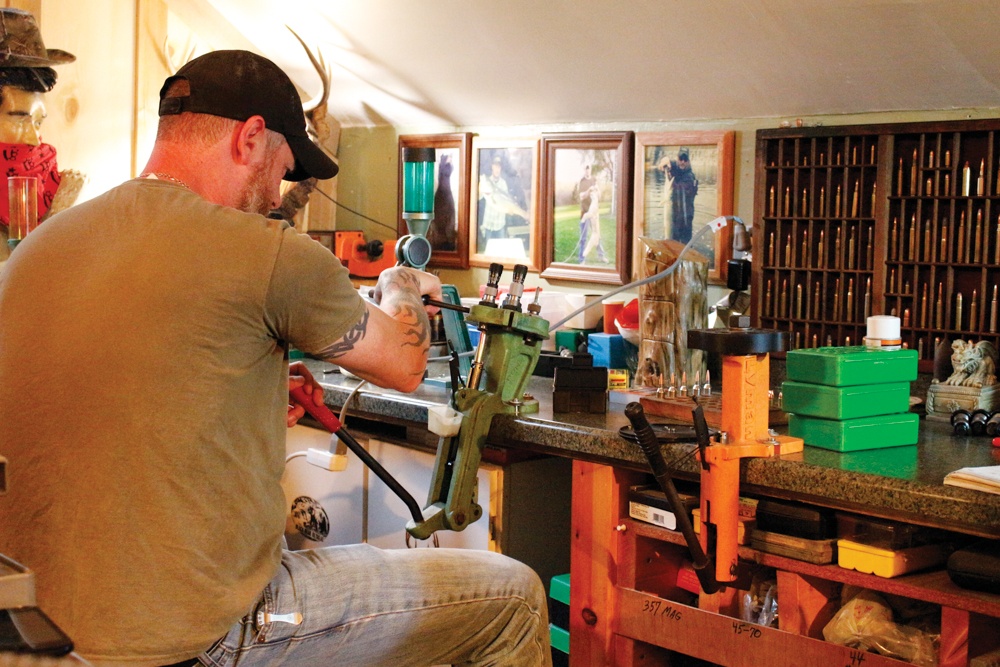
Barnes highly recommended using Ramshot’s Enforcer as well as Accurate No. 9, as their laboratory testing found these powders to give the best results with their bullets.
This company has come a long way since 1932 when Fred Barnes started making bullets. They are something all handloaders need to try.
I’m loading those Hornady XTPs for our local deer and bear seasons. The Gold Dot bullet will remain my favorite for the liberal coyote season we have here in New York, and the Barnes 225-grain XPB is getting the nod for an upcoming feral hog hunt.
With this trio of bullets, I’m very well covered for anything smaller than coastal brown bears! I have really enjoyed the testing of these new powders and bullets, and it has truly brought newfound interest to my pair of classic revolvers.
I am glad I knocked the dust off these two classics and tried modern loads through them. It has shown me how far reloading products have progressed and has given me new respect for my old iron.
Editor’s Note: This excerpt is from Handloader’s Digest, 19th Edition available now at GunDigestStore.com
DISCLAIMER: Any and all loading data found in this article or book, including past or future editions, is to be taken as reference material only. The publishers, editors, authors, contributors, and their entities bear no responsibility for the use by others of the data included herein.

Next Step: Get your FREE Printable Target Pack
Enhance your shooting precision with our 62 MOA Targets, perfect for rifles and handguns. Crafted in collaboration with Storm Tactical for accuracy and versatility.
Subscribe to the Gun Digest email newsletter and get your downloadable target pack sent straight to your inbox. Stay updated with the latest firearms info in the industry.

![Best Concealed Carry Guns In 2025 [Field Tested] Wilson Combat EDC X9S 1](https://gundigest.com/wp-content/uploads/Wilson-Combat-EDC-X9S-1-324x160.jpg)


![Best 9mm Carbine: Affordable PCCs [Tested] Ruger Carbine Shooting](https://gundigest.com/wp-content/uploads/Ruger-Carbine-Shooting-100x70.jpg)
![Best AR-15: Top Options Available Today [Field Tested] Harrington and Richardson PSA XM177E2 feature](https://gundigest.com/wp-content/uploads/Harrington-and-Richardson-PSA-XM177E2-feature-100x70.jpg)
